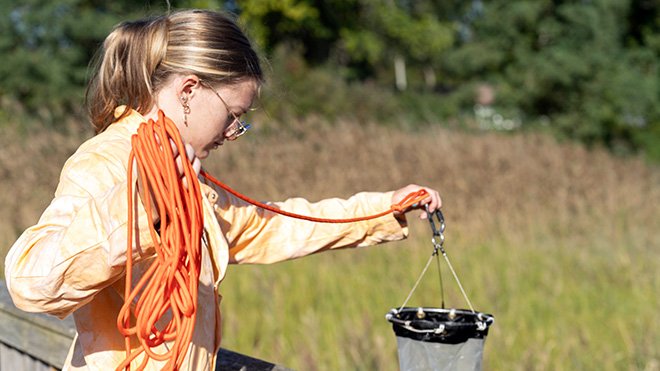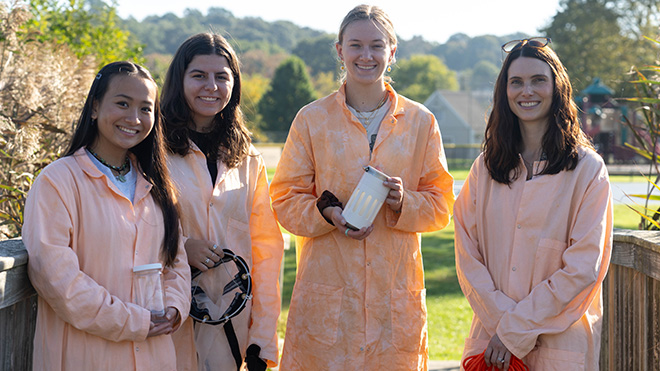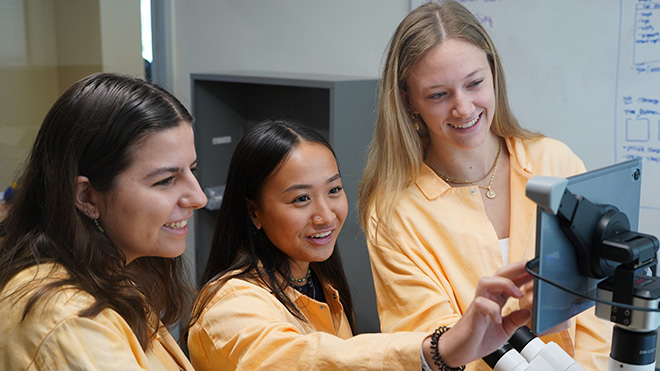How Many Microplastics Are in Narragansett Bay? RWU Students Intend to Find Out
Engineering and Chemistry student researchers collaborate to create a database showing the amount and type of microplastics in the bay.

BRISTOL, R.I. – On a sunny October morning, senior Michelle Kryl lowers a phytoplankton net into the water at Silver Creek in Bristol, R.I. After five minutes, she pulls up the net, unscrews a cylinder attached to the end of the net and passes it to junior Ashlee Lewandoski, who pours the contents in a sieve and captures the remaining particles in a jar. They then head back to their lab in the Richard L. Bready Applied Learning Laboratories building at Roger Williams University, to test their samples to see if they contain any microplastics.
Kryl, an Environmental Engineering major from Westhampton Beach, N.Y., and Lewandoski, an Environmental Engineering major with minors in Mathematics and Sustainability Studies from Bristol, Conn., are part of a multi-year student research team. Since last fall, Engineering and Chemistry students have been working with Lillian Jeznach, Associate Professor of Engineering at RWU, on an interdisciplinary research project to determine the volume and types of microplastics entering Narragansett Bay. They have started a long-term microplastic sampling campaign to develop a database of freshwater and atmospheric microplastic measurements in Rhode Island. Part of their work will also create sampling and analysis methods that are accessible to all Engineering undergraduate students in the program to encourage their participation and engagement with this global problem.
Jeznach was inspired after hearing Rhode Island Department of Environmental Management officials comment on the lack of microplastics data in the state and how difficult it is to obtain. Microplastics pollution is a growing concern for Rhode Island, which has high urban land cover and relies on the Blue Economy. To address what it calls the “worsening crisis of microplastic pollution,” RIDEM drafted regulations for the Plastic Waste Reduction Act, which was signed into law last year. Microplastics, officials noted, can be ingested by fish, shellfish, and other sea life and then by humans. This is not just a local issue. According to the National Institute of Environmental Health Sciences, “researchers estimate that 10 million metric tons of plastic waste and microplastics (tiny plastic fragments smaller than five millimeters in size) enter the oceans each year.” They project that number will be 150 million tons by 2025.
“Undergraduate student research can contribute valuable data to help fill microplastic knowledge gaps,” said Jeznach. “I thought this would be a great opportunity to get students involved in this very interdisciplinary topic. Our hope is that we can provide some data to the state about the different sources of microplastics inputs to Narragansett Bay from both freshwater and atmospheric sources, which might also inform future policy.”
The project, which began in the fall 2022 semester, has received funding from the Narragansett Bay Estuary Program; the RWU Blue Tech Challenge; RWU’s School of Engineering, Computing, and Construction Management; RWU’s Foundation to Promote Scholarship and Teaching; and RWU’s NSF RISE Scholars program.
How It Works
The students in Jeznach’s lab are creating standardized methods for sampling microplastics “because there really isn’t a lot of information regarding that area,” said Lewandoski, who joined the team over the summer. “We’ve been sampling different areas in Rhode Island and testing different analysis methods.”
To test for microplastics, students collect both freshwater and atmospheric samples. Freshwater sites – chosen based on their flow, accessibility, and other factors – are located on two major rivers in Rhode Island that discharge into Narragansett Bay: Pawtuxet River and Woonasquatucket River. Students collected samples off the Broad Street Bridge in Cranston, at the Esmond Park Conservation Area in Smithfield, and off Atwells Avenue in Providence.
Atmospheric samples were gathered using a student-designed prototype based on a particulate fallout collector, which was installed on RWU’s campus near the parking garage. The device consists of a wooden stand with a rectangular stainless-steel canister placed on top to collect particles from the air.
After a process of collecting and filtering samples from both water and the atmosphere last spring, the students conducted a visual analysis with a binocular compound microscope to determine if any particles were microplastics. They took note of the number, color, and shape.

Over the summer, Lewandoski and Grace DiBlasio, a junior Chemistry major from North Andover, Mass., began implementing a different analysis technique: they put Nile red dye on the samples, which when viewed under a blue light, causes microplastics to fluoresce so they are easier to see. The two students made a retrofitted blue-light microscope and said this new method helps speed up the process.
What has the team found in the samples they’ve collected? From both the freshwater and atmospheric collections, “we always find microplastics in every sample we do,” Jeznach said. “It’s more than what I expected when we first started.”
They are now tabulating their results and preparing the database to share with RIDEM and other researchers. Any data collected on microplastics can be useful for driving policy change and changes in consumer behavior, both Jeznach and Kryl said. Their research could even extend beyond the borders of Rhode Island.
“Microplastic pollution has become a big problem,” said Kryl. “I like the idea of creating a database and having it be used widespread. I think students at other schools would be able to take the work we’re doing and add to it.”
Combining Disciplines Creates More Powerful Results
Working in both the field and the lab provides valuable hands-on opportunities for the students who are able to apply the skills they learn in class. “They’re learning on the fly, which is a lot different from what we do in class,” Jeznach said.
For Kryl, being a part of this experience has inspired her to apply to graduate school. “This helped me realize that research is a good part of what I want to do in my career,” she said.

Over the summer, Jeznach intentionally paired Lewandoski and DiBlasio together, so they could combine their respective expertise in Engineering and Chemistry to grow the analysis methods they were implementing and learn more. The students say they benefit from the interdisciplinary nature of the research.
As a Chemistry major, DiBlasio said her favorite part has been learning about the engineering design process. “I had no experience with that,” she said. “It was cool to see exactly what that means – how to set up a project, what the steps are, and how we can improve it. I loved the collaboration.”
Lewandoski said working with DiBlasio over the summer showed her how important interdisciplinary work is. “A lot of things that we’ve done couldn’t be done without the Chemistry department,” she said.
Jeznach noted she would welcome working with more Chemistry and Environmental Science majors on this research. She expects to do more sample collection in the spring and hopes to see this project run for years in order to collect as much data as possible.
“This has been a great team. The students do 99.9 percent of the work,” Jeznach said. “I don’t typically do lab work. They know how to work the microscope. They know how to do the analyses way better than I can do. The students are really the experts.”